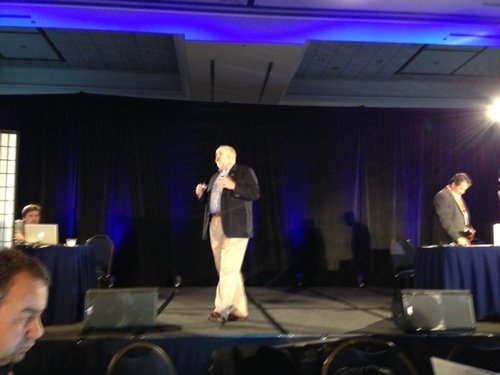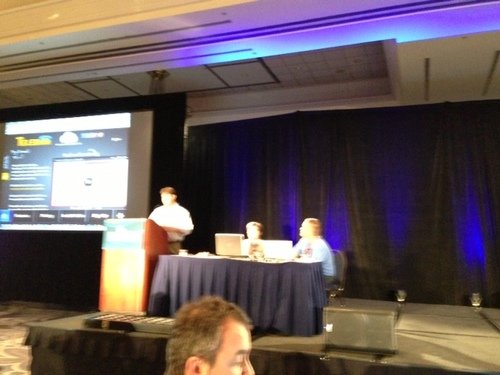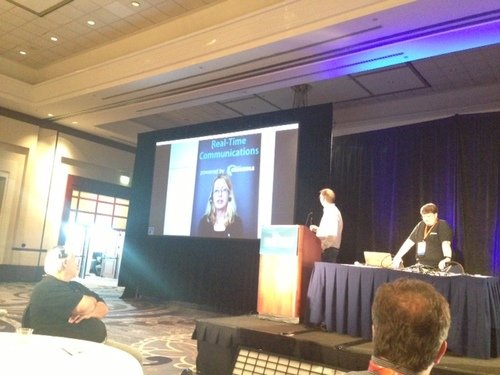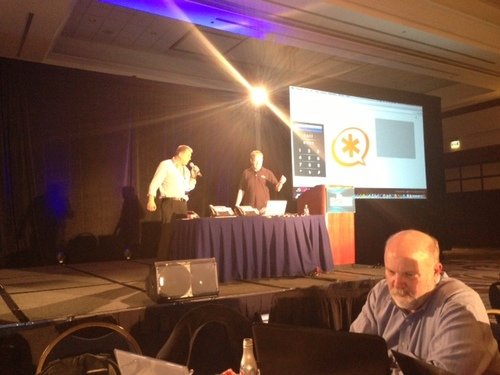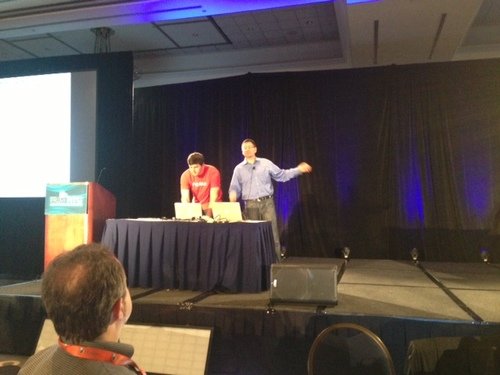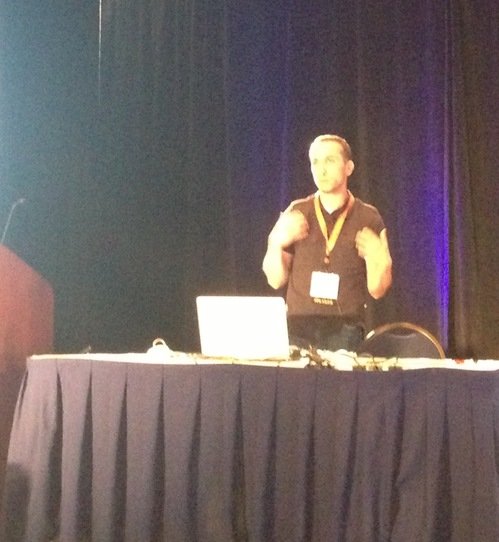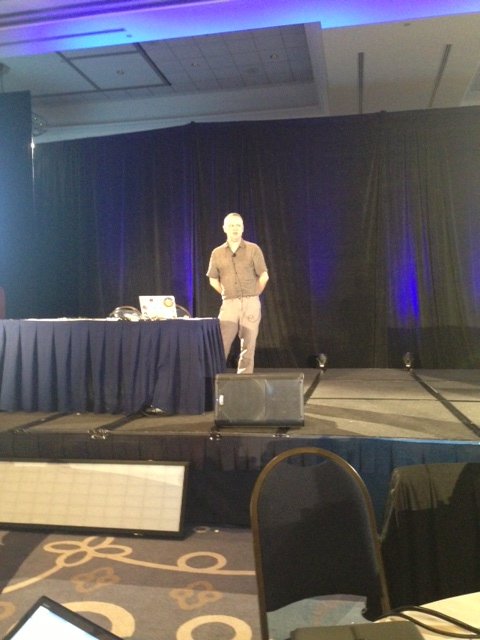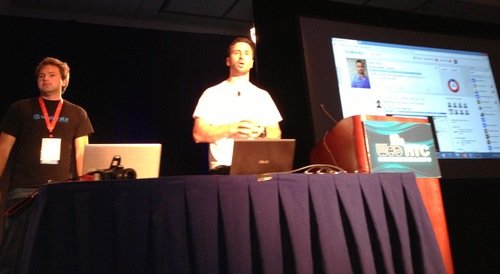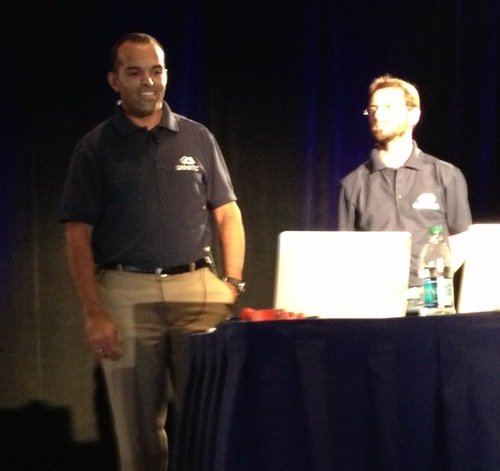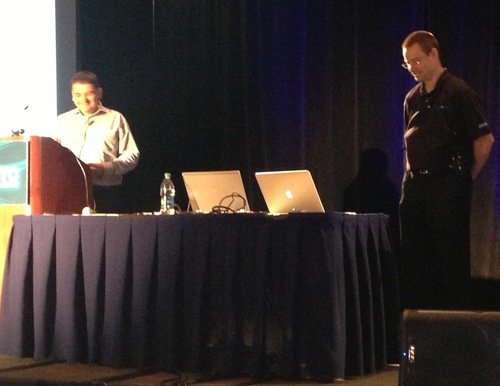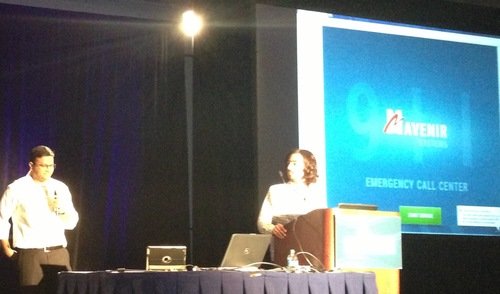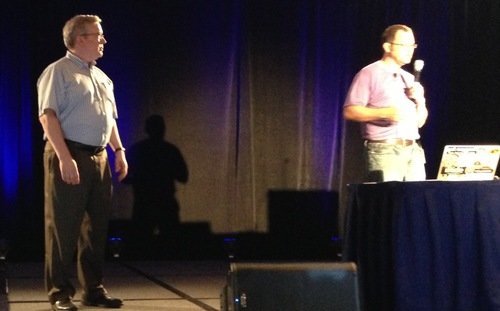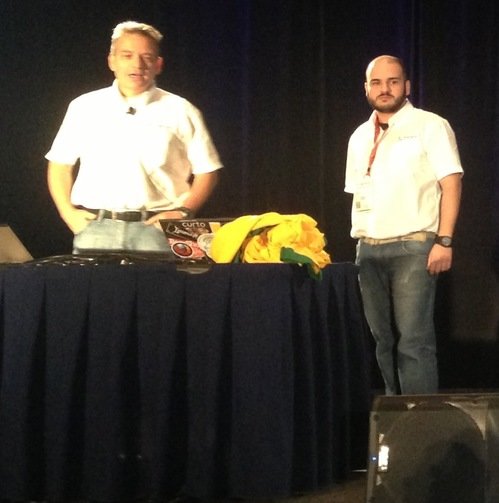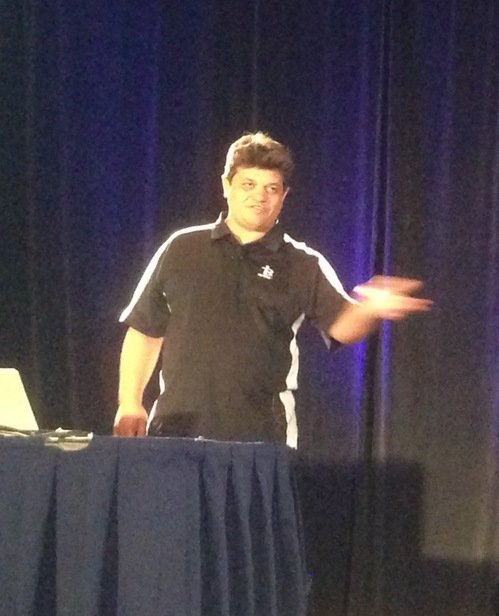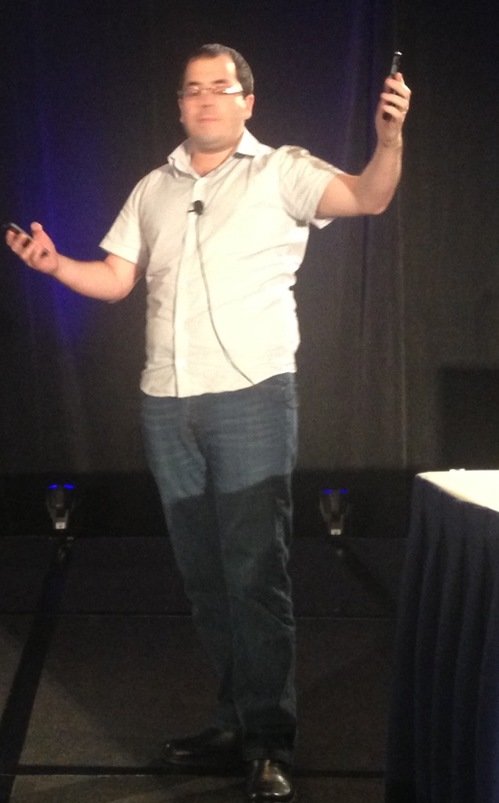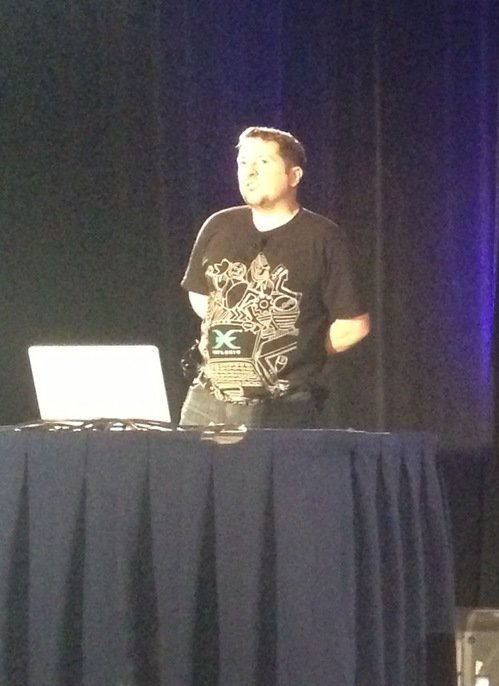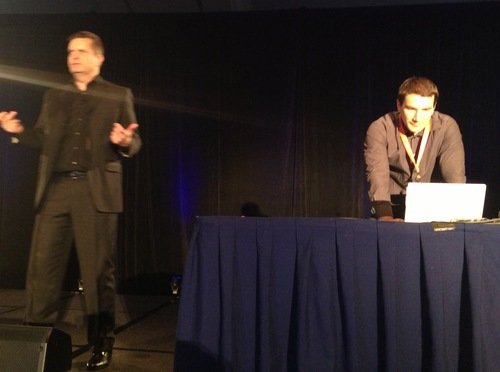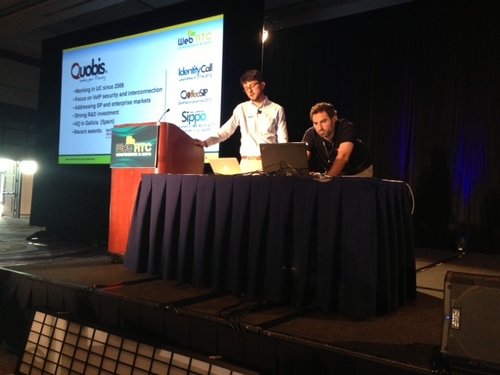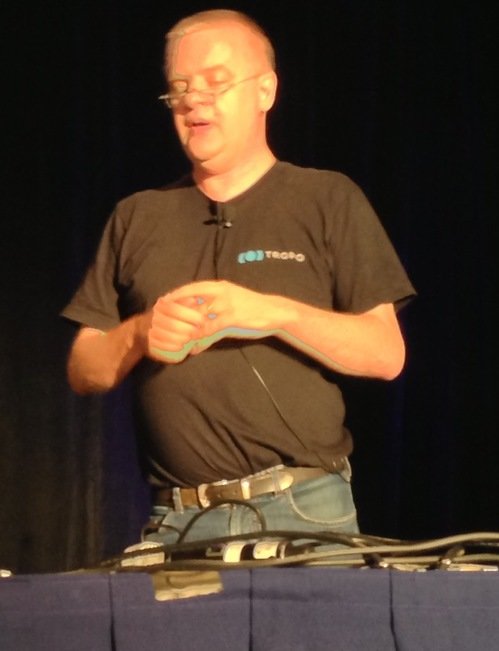- See photos from the show.
- See demo videos from the first night.
Day 1 June 25, 2013
WebRTC Expo 2013 Atlanta kicked off today and so far it has been a great event and well attended. I will share all the things I can on this page as the show progresses.
Earlier today I stopped by the Google WebRTC Workshop but it was too busy to sit or even stand so I took some video and photos and left.
I then went to the general session to see the WebRTC demos. I was lucky enough to get here early and sit with the independent judges – I am not one of them.
Phil Edholm then took the stage to get the event started.
He was followed by the first demo which was Requestec who showed a banking demo and a call which allowed a Flash user to communicate with a WebRTC user. They believe they are the first to allow Flash to WebRTC interop. They also showed a mixed-device demo with recording capability.
Teledini showed click-to-call functionality and “converting web browsers into customers.”
Inventive Labs showed how you can integrate WebRTC with legacy secure SIP endpoints. The demo consisted of a dialer which could discern when to leave a message – after the tone on an answering machine for example. One of the live calls had an audio problem on the sending end but not the receiving as we could hear the caller.
Crocodile showed their Javascript SDK which allows you to connect securely to a network built on open source. You can access SIP peering, QoS, file transfer and more.
They also showed a demo of a therapist using WebRTC to help customers – it was quite funny and Suzanne Bowen did a great acting job. The point was using WebRTC you can increase the price of the call as it takes place pushing the caller to speed up and/or pay more.
Next up was Digium who showed how you could make a WebRTC call via Asterisk for free. There was a Rasberry Pi computer which wirelessly connected to a MacBook running WebRTC – the company stressed this is all free.
PubNub showed “democratizing real-time” allowing real time connections in a quarter of a second. Among others, they showed Galaxy which is a multicast service – this is used for games, call signalling and more.
Ingate showed how you could connect WebRTC to the POTS network. Q-TURN is the product which allows this and a demo showed how traffic shaping allows a video call to be of the highest quality.
France-based Apidaze showed an API which SMS-based apps for “simple-to-complex telephony.”
Priologic showed their Tawk.com service which allows fast, secure, anonymous video chat rooms. The service is targeting 13-30 year olds and is bound to drive the NSA and other snoopers crazy.
Hypervoice Consortium discussed applying the benefits of hypertext to voice – thus the name. This means making voice recordable and integrated into our workflow. Also it has to be shareable and part of our daily experience. Finally, he said voice needs to be searchable.
He then demonstrated how this would work – with each utterance being searchable. You can hen take a phone call and index it and determine what was said.
Thrupoint showed how you could integrate “legacy” SIP with WebRTC. The demo showed multiple devices communicating via WebRTC and SIP via a banking application.
Temasys showed a multipoint video call with participants around the world with four parties in conference. They believe this is the first public demo of WebRTC over satellite (from Africa.)
PubNub was the audience choice winner – congratulations!
Day 2 – June 26 8:34 am
Phil takes the stage again and thanks the sponsors, moderators, judges, etc. He then sets up the day – giving an overview of the day’s conferences.
Ian Small CEO Tokbox takes the stage for the keynote. He says “We are living in the future.” He said the future is here in the room with us today. He said you can build “skyscrapers” with WebRTC but the tools make it hard to get started. He mentioned 450M new users are coming online thanks to Firefox.
He listed some of the challenges with WebRTC development – here are less than half of them:
- Low bandwidth devices
- broadcast
- recording
- routing and scaling traffic
- PSTN interop
- moderation
He then discussed all the possibilities of WebRTC – multiparty conferencing, being able to listen to calls in an undetected fashion, etc. He said to make WebRTC work we need to consider that the technology needs to vanish so users can use WebRTC as easily as they use HTTP today. He continued, when you can add WebRTC into your business easily – then WebRTC becomes a fabric of the online world.
8:57 am
Ian also discussed how WebRTC gives you phenomenal video quality but not all endpoints are capable of handling this quality. He mentioned his Mantis platform allows for intelligent signal adaption which improves the video experience for users. He showed an example of how the system tells users on slower devices that the video quality has degraded and continues an audio-only call until the signal quality improves.
He then showed a demo of a site which allows face-to-face chat with a call center agent. The agent was able to seamlessly push photos to the user as needed. The call escalated to a manager and at this point both the agent and manager were on the line – both were side-by-side, communication on the web page.
9:15 am
Geoff Hollingworth with Ericsson is about to give a presentation/panel titled “It’s The Economy Stupid.” He started off showing a typewriter and asking how many people have used one. He then showed the audience a rotary phone and asked who used one. He mentioned that children don’t know how to use one.
He then went on to say Ericsson is one of the original founders of WebRTC with Google. The reason for this he says is the original typewriter companies wished they jumped onto the next big thing – Ericsson is embracing the future.
At this point, panelists came to the stage. They consisted of Scott Lomond with Tokbox, Bard Rosell, AT&T and Jean-Baptiste “Jb” Piacentino of Mozilla.
Some of the takeaways were that every business with a computer will be affected by WebRTC. New business opportunities include high-end customer service as well as an opportunity for large brands to reinforce their place in the marketplace with live video.
More: This is a standard emerging at internet speed for the first time – and as new businesses are added on top of the platform which add value, there is a lot of money to be made. Scott mentioned that being disruptive for the sake of disruption does not guarantee making money.
Bard said that if a lot of new businesses are started based on technology that we all provide, then we all win.
Jb said the future is bright.
Final thoughts: Make sure you are solving a real problem that matters to businesses in some way.
—
4:47 pm
Its been a great day so far – on to more demos
Solaborate takes the stage to show off their social networking platform for the tech community. The idea is to provide real-time collaboration, news, information and more in a single platform.
WebRTC as you may have guessed adds real-time collaboration to the mix. The company showed some demos of collaboration in action with screen sharing an code pushing and more. They also showed a tablet user on the system.
Ian Small of Tokbox takes the stage and shows videoconferencing with multiple parties as well as chatting. Ian showed not screen “sharing” but screen “pushing” – the difference is you may not want a customer to see all the screens the agent cycles through – just the one they choose to push. The takeaway is helping developers build enterprise-grade WebRTC solutions.
Bistri showed a demo where you can click on a single web link to initiate a WebRTC video calling session with screen sharing and more. Developers can access the free APIs and you pay only for the call but you get unlimited minutes.
Presence Technology showed off WebRTC in the call center which had the benefit of allowing remote agents and/or a disaster discover scenario.
Weemo showed their cloud based video service which can be embedded anywhere such as business or mobile applications. The service leverages WebRTC where possible and provides multiparty video. The company was based in France but is now in San Francisco.
The company showed a p2p call between IE/Flash to WebRTC without a transcoder in-between. The demo included a multiparty call put on hold when another call came in and then they ere all connected in a four-way call with screen sharing and mute capability.
Erik Linask is also live blogging this event.
Dialogic showed their PowerMedia XMS solution. First they explained why a media server is needed in WebRTC. They exlplained use cases like PSTN to WebRTC where there is a codec mismatch. Also when there is conferencing taking place you need automatic gain control and call recording. They went on to say a media server helps solve these problems.
The company showed multiparty videoconferencing over disparate hardware where the video is mixed on the media server. He went through all the various codecs being used and how the system transcodes it all on the fly.
5:44 pm
Mavenir takes the stage to show their WebRTC gateway which provides APIs for carriers which allows them to develop applications. They showed a use case of an emergency responder placing a call and being connected via live video.
Daitan Group started by saying they are consultants and decided to show tech demonstrations which leverage their telecom background. They showed WebRTC over IMS. The company showed some PowerPoints and discussed how they use Project Clearwater (from Metaswitch) to make all this happen. They did a demo with video and screen share.
Alcatel-Lucent showed their WebRTC ecosystem with partner Vobi – he presented some problems… Communications should be fluid but information is disjointed and services are siloed.
The demo showed how users could communicate phone to phone where IMS generates a call event which tells both users there is a call in process. The call then takes place and Vobi curates content relevant to the call. Once a user drags something onto a screen the other user has access to it. Every call in-turn becomes a contextually relevant conversation. Likewise – a voice call can become instantly a multiparty video call.
Every call now becomes an asset and content can continue throughout the lives of the user like an enhanced CDR. This extends mobile out of the device and into the browser.
From there Alcatel-Lucent explained how they are working with partners and gave a list of reasons why it makes sense for developers to work with their company.
6:10 pm
vLine showed their solution for WebRTC developers including STUN, TURN, MCUs, a messaging service, signaling, presence, chat with offline message support – notifications and more. The company also has a powerful developer framework allowing you to customize your user experience. Notifications and call control are a few other reasons a developer should continue working with the company rather than building from scratch.
The company showed off a video call with embedded call controls and in a call with customer BLOC the representative discussed how they use WebRTC now as opposed to a past product they used which required downloads and crashed often.
Sansay showed their carrier to WebRTC gateway with embedded SBC. They had a Demo app which decrypts and transcodes. The demo included presence, data channel, voice and video. We saw a video conversation with chat. Sadly the laptop ran out of battery and the demo was cut short.
Instant Solutions started out with a humorous intro to their session and gave away Brazilian soccer shirts. They then asked for an audience volunteer. They then showed a WebRTC call center demo with lots of other features such as call recording, ACD and an app which allows users to navigate through company IVR quickly.
Symonics discussed spatial audio in conferencing and discussed their announcement from the show which adds spatial audio to WebRTC communications. The technology is similar to what we’ve seen from DiamondWare/Nortel Project Chainsaw/Avaya in the past. Very interesting.
BitAction showed you can connect a smart device on a cellular network to another smart device in a P2P fashion. The company’s P2P SDK works in about a one-quarter of the time and in other cases needs a relay. The demo showed how two cellphones could be quickly connected and the server could then be disconnected and the call would persist.
Vonage showed their mobile app and went through all the functionality including video calls.
Xirsys showed their WebRTC services and mentioned they want to help provide an entire ecosystem which powers other people’s webRTC requirements from a back-end. The company has STUN and TURN servers in the cloud, a CDN, analytics, security, and a simple, complete messaging layer. There was no demo instead we some some slides on what the company does. The idea behind the company is to provide tools for emerging technologies such as HTML5 and we can expect more server and client side tools soon.
7:12 pm
Browsetel showed a click-to-call solution using WebRTC with web chat and co-browsing. They finished off showing a Rasberry Pi sized PC for less than $100 which runs Android and Chrome – which he inferred is the future. Sadly the time ran out so we were left wondering about the specifics but i is likely that these things will make great WebRTC endpoints.
Quobis showed their enterprise solution which supports UC methods such as audio and video. In addition there is address book, provisioning APIs, presence, privilege management and CDR integration.
The company’s system has security which deals with DoS, DDoS, malicious webserver fraud, illegal interception and more. There is also authentication, identity and more. Finally, there is interconnection with numerous signaling protocols supported.
Voxeo Labs showed the Phono API demo on a mobile device. The company helps devlopers by abstracting the details of the device, browser and software. Developers don’t need to know if you are using Flash or WebRTC for example as the system handles these details. Think of how Windows fist supplied printer drivers meaning each developer such as Lotus 123 back then didn’t need to ship boxes
of printer drivers on diskettes (remember them??).
We then saw some javascript snippets and a live call which was made accidentally to a local hotel which made the presenter say “oops” and hang up. Too funny. The audience loved it.
Other services showed via PowerPoint were virtual training group with the ability to add and subtract users from various groups to make it like real life training.
He also discussed twelephone – which allows a Twitter communication to upgrade into a real-time user experience.
Bolder Thinking showed their cloud-based telephony platform which allows them to scale “infinitely” and take advantage of an elastic infrastructure.
The first demo showed a call center agent who took the call and – could see who is calling and look at the pre-populated data from the user’s browsing history.
The company then showed call center reporting as well as speech recognition. The company can also bridge WebRTC to SIP or PSTN.
8:00 pm
And the demos are over.. The audience is now deliberating.
The winner is…
vLine won – congratulations!!!!!!


